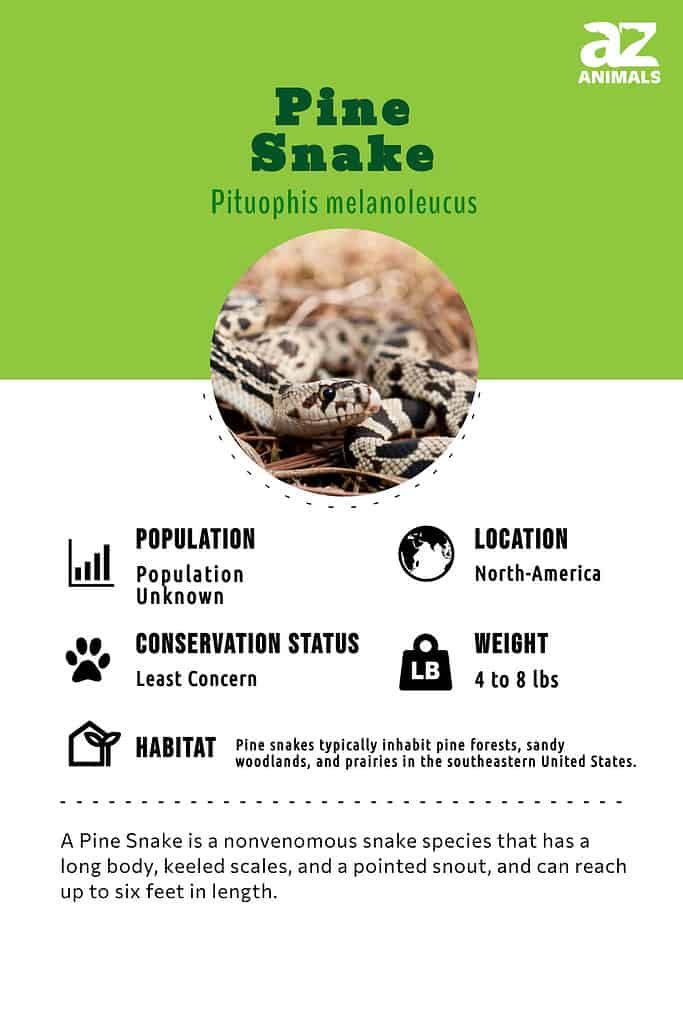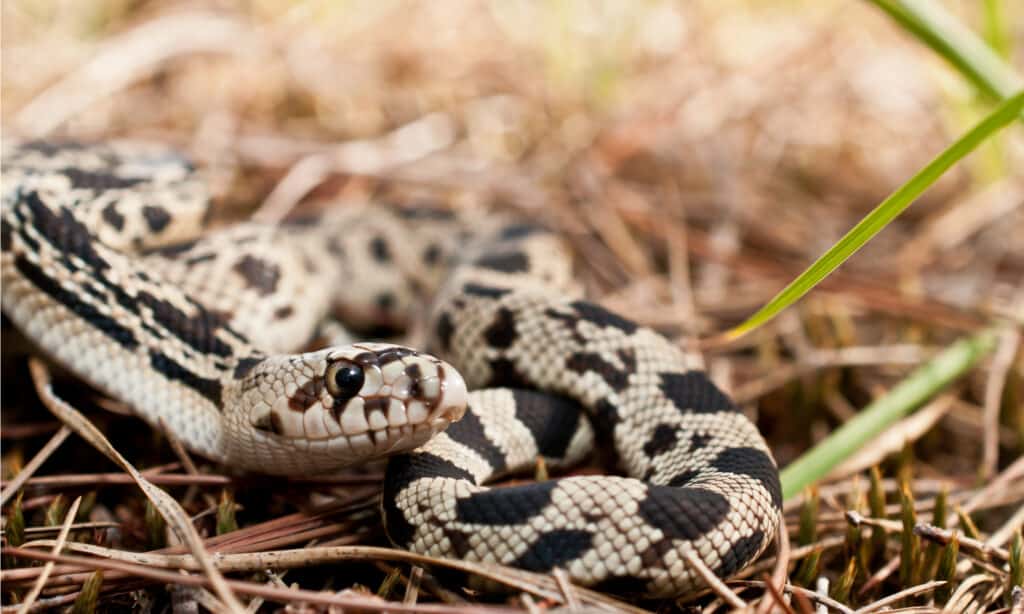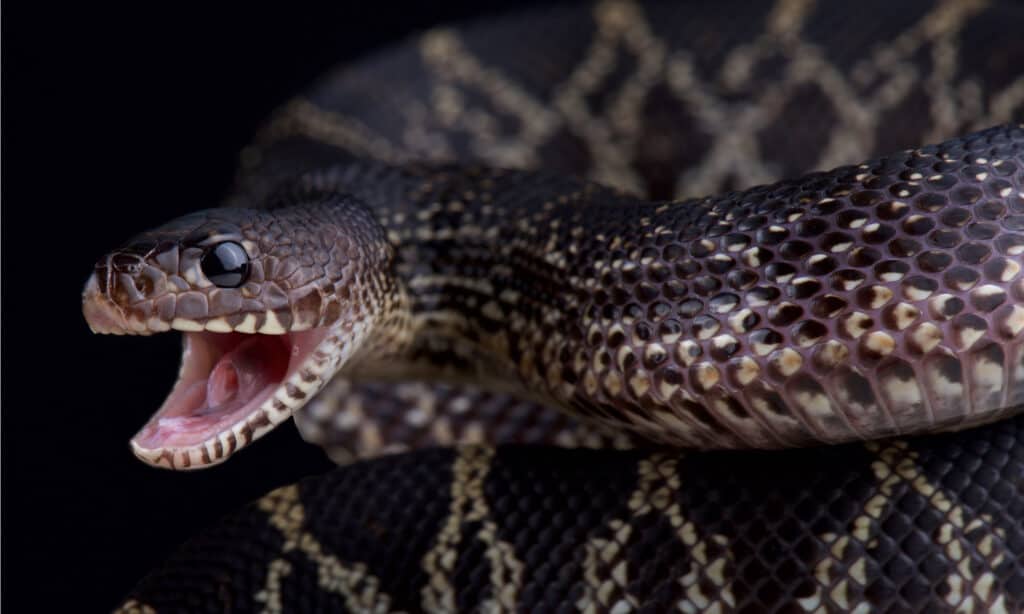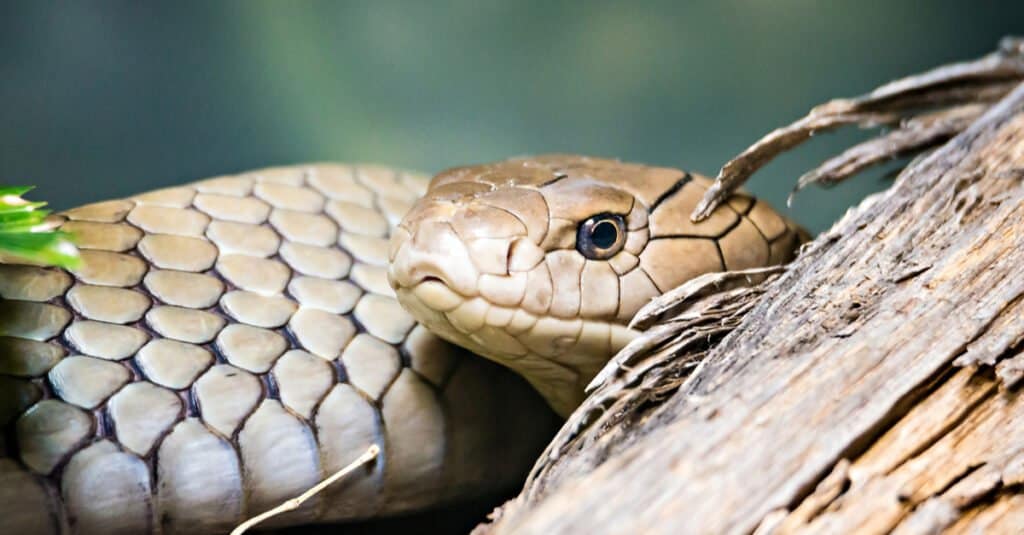Pine Snake
Pituophis melanoleucus
Pine snakes bluff with the best, trying to scare you away.
Advertisement
Pine Snake Scientific Classification
- Kingdom
- Animalia
- Phylum
- Chordata
- Class
- Reptilia
- Order
- Squamata
- Family
- Colubridae
- Genus
- Pituophis
- Scientific Name
- Pituophis melanoleucus
Read our Complete Guide to Classification of Animals.
Pine Snake Conservation Status
Pine Snake Facts
- Prey
- Rodents, birds, eggs
- Name Of Young
- Hatchlings, snakelets
- Group Behavior
- Solitary except during mating season
- Fun Fact
- Pine snakes bluff with the best, trying to scare you away.
View all of the Pine Snake images!

The pine snake is native to the southeastern region of the United States.
It is a non-venomous constrictor that lives in prairies, pine forests, and other environments. The pine snake resembles a rattlesnake, but it is harmless to humans.
3 Amazing Facts About the Pine Snake

The pine snake goes into a state of hibernation beneath the ground and possesses a snout that is specifically adapted for digging.
©Jay Ondreicka/Shutterstock.com
• It hibernates underground and has a snout designed for digging.
• If threatened, it shakes its tail to look like a rattlesnake.
• The Louisiana pine snake is the rarest snake in the United States.
Evolution and Origins
The Pine Snake, scientifically known as Pituophis melanoleucus, belongs to the Colubridae family of snakes and is native to North America.
The Pine Snake is believed to have evolved from a common ancestor with the Bull Snake, with both species sharing similar physical characteristics and behaviors. Fossils of ancestral Pituophis have been found dating back to the Miocene epoch, around 23 million years ago, indicating that the genus has existed for a considerable length of time.
The Pine Snake’s habitat includes pine forests, prairies, and coastal dunes, where it feeds on small mammals and reptiles.
Despite its wide range, the Pine Snake’s populations are threatened due to habitat loss and fragmentation, making conservation efforts crucial for its survival.
Different Types
Four different types of pine snakes exist, namely the northern pine snake, black pine snake, Florida pine snake, and bull snake, with the northern pine snake featuring a black or dark brown marking on its back, and a white underbelly with black dots running along both sides.
Where to Find Pine Snakes

Black Pine SnakeThe snakes are indigenous to the southeastern pine forests and grasslands.
©reptiles4all/Shutterstock.com
These snakes are native to the pine forests and prairies of the southeast. Throughout their range, they are found in a variety of habitats. They live in the coastal plains of southern states like North Carolina, South Carolina, and Georgia. They also live in the northern mountains of Virginia and Tennessee. There are pine snakes in the southern pine barrens of New Jersey, the grasslands of Alabama, and even in the southern region of Wisconsin, where they are called gopher snakes.
Where to see them in zoos

Pituophis melanoleucus is the scientific name of this snake species which has several common names like chicken snake, bull snake, pilot snake, white gopher snake, and pilot snake.
©Nathan A Shepard/Shutterstock.com
• Smithsonian National Zoo
• Audubon Zoo
• Memphis Zoo
• Maryland Zoo
• Utica Zoo
Scientific Name
Its scientific name is Pituophis melanoleucus. It has many popular names, including chicken snake, bull snake, pilot snake, white gopher snake, and pilot snake.
There are four subspecies of the pine snake:
• Northern pine snake
• Black pine snake
• Florida pine snake
• Bullsnake
Population and Conservation Status

Pine snakes have a broad distribution, and they are considered of low conservation concern according to the IUCN Redlist.
©digidreamgrafix/Shutterstock.com
Pine snakes are widespread in their range, and they are classed as “least concern” by the IUCN Redlist. Like all snakes, however, they have suffered population declines because of habitat loss and other factors.
They are listed as a species of special conservation concern in Georgia, and it is illegal to kill them under Georgia law. Their population is also considered threatened in Southern New Jersey. Conservationists believe they have been extirpated in Maryland and West Virginia, but wildlife biologists in Maryland say they still live in the Isle of Wight, a state Wildlife Management Area.
In 2020, the Audubon Zoo, Memphis Zoo, and U.S. Forest Service released 41 Louisiana pine snakes into the Kisatchie National Forest in Louisiana. The release of these juvenile snakes marked the end of a years-long process to raise them in captivity and reintroduce them to their former range. This subspecies of the northern pine snake is classed as endangered by the IUCN. It is considered the rarest snake in the U.S.
Appearance and Description
This is a large snake that reaches six feet in length and up to 9 pounds in weight. It has a large, stocky body with a distinct pattern on its scales. Typically, it has a light gray background with blotches of black, brown, and reddish-brown. These patches are usually darkest near the head and lighter near the tail. It has a white belly edged in dark spots.
Unlike other members of the colubrid family, which have two prefrontal scales, it has four. It also has a pointed snout that helps it dig burrows to hibernate in during the winter.
Venom: How Dangerous Are They?
Despite their large size and intimidating defensive posturing, these snakes are not dangerous to humans. They are not venomous or poisonous. Their bite can be painful, but they will only bite if provoked.
Behavior and Humans
Pine snakes are skilled hunters. They are diurnal but will sometimes hunt at night. They are shy, reclusive animals who spend much of their time in their underground burrows.
They reproduce in the spring and summer. Females use their snouts to dig burrows, and they lay their eggs in these burrows. Most females return to the same burrow every year to lay their eggs. They lay from 12 to 20 eggs that incubate for about three months. Baby pine snakes are noteworthy for their size. They can be over a foot long at birth.
Human interaction
Although pine snakes are not venomous, they have adapted a technique that mimics the actions of the highly venomous rattlesnake. When a pine snake feels threatened, it will make a hissing sound while shaking its tail. This is an adaptation designed to make predators think it’s a rattlesnake. It may also bellow loudly to scare away the predator.
These snakes hibernate in the coldest part of the winter. They do this by using their snouts to dig underground burrows for shelter.
Pine snakes are non-venomous and harmless to humans. They may bite if they are threatened, but they have no venom.
View all 192 animals that start with PPine Snake FAQs (Frequently Asked Questions)
Are pine snakes venomous?
No, they are not venomous. Their bite is painful, but it is not poisonous.
How do they hunt?
Although they are constrictors, they use a very unusual technique to hunt and kill their prey. When a snake spots a rodent burrow, it enters the burrow and presses its body against the wall. By doing this, it can immobilize several animals at once. It then uses constriction to kill its prey.
These snakes have several hunting techniques. They use their snouts to dig into rodent burrows and chase their prey. They are also excellent climbers who can climb trees in search of birds and bird eggs.
Are they aggressive?
They are not particularly aggressive, but they will fight back if they are threatened or attacked. Their large size, heavy weight, and warning hiss may scare off many predators, but they prefer to flee rather than fight.
Where do they live?
They primarily live in the southeast. Their range is most widespread in Louisiana, Alabama, Georgia, the Carolinas, and Florida. However, there are pine snakes in northern states like Wisconsin and New Jersey.
What do they eat?
They eat rodents, birds, and bird eggs. Juvenile snakes eat small rodents, lizards, and insects.
Where are pine snakes found?
They are mostly found in pine forests and prairies, but they have adapted to life in a variety of environments. They can live in woodlands, cultivated fields, mountainous areas, and rocky deserts.
How big do pine snakes get?
They can reach 6 feet in length and 6 to 9 pounds in weight.
Are pine snakes harmful?
They are not harmful. They are non-venomous snakes who prefer to be left alone.
Are pine snakes good pets?
No, they are not good pets. They are wild animals who don’t enjoy human contact. Although they are not aggressive, they will bite if they feel threatened, and their bite can be very painful.
What does a pine snake eat?
It eats mice, voles, birds, and bird’s eggs. Young snakes may eat lizards and insects.
Are there pine snakes in Wisconsin?
Yes, but they are known as gopher snakes in Wisconsin.
How big is a baby pine snake?
A baby pine snake can be 12 to 18 inches in length. The juvenile will grow quickly to its full size of 6 feet.
What is the difference between a copperhead and a pine snake?
The main difference between a copperhead and a pine snake is that copperheads are copper-colored, venomous, and live all over the eastern United States. Pine snakes are brown and white, aren’t venomous, and live only in the southeast.
Thank you for reading! Have some feedback for us? Contact the AZ Animals editorial team.


















